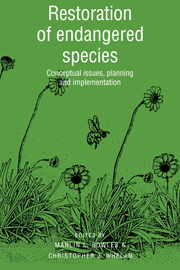IV - Synthesis and future directions: biology, politics and reality
Published online by Cambridge University Press: 27 January 2010
Summary
In the forward, we posed two related questions. First, do biological differences between animals and plants imply different restoration strategies and regulations for these two major groups of organisms? Second, how should political boundaries, which are clearly ‘extra-biological’, play a role in restorations? Upon reflection of the contributions in this volume, we here briefly offer our views.
Perhaps the most obvious, potentially important difference between animals and plants in restoration is the mobile lifestyles of animals versus the sedentary lifestyles of plants. This difference, we have found, appears to have led to a general belief that animal and plant restorations often pose different sorts of problems, particularly with respect to ‘ecotypes’, or genetic adaptation to biotic and abiotic environmental components, ranging from soils and climate, to competitors and mutualists. Put another way, this view assumes implicitly that animals and plants tend to differ in profound ways with respect to genetic population structure, which should dictate different restoration strategies and/or guidelines. But the rather obvious difference of mobility masks a perhaps lesser difference in vagility. We now recognize that many plants are capable of impressive pollen and/or seed dispersal, while some animals disperse very little among separated populations. Differences with respect to genetic population structure are likely to vary widely among taxa, irrespective of animal or plant (Hamrick 1992). Further, the genetic structures of animal and plant populations are becoming better understood only recently, with the application of powerful, but recently developed, molecular techniques.
- Type
- Chapter
- Information
- Restoration of Endangered SpeciesConceptual Issues, Planning and Implementation, pp. 351 - 354Publisher: Cambridge University PressPrint publication year: 1994



